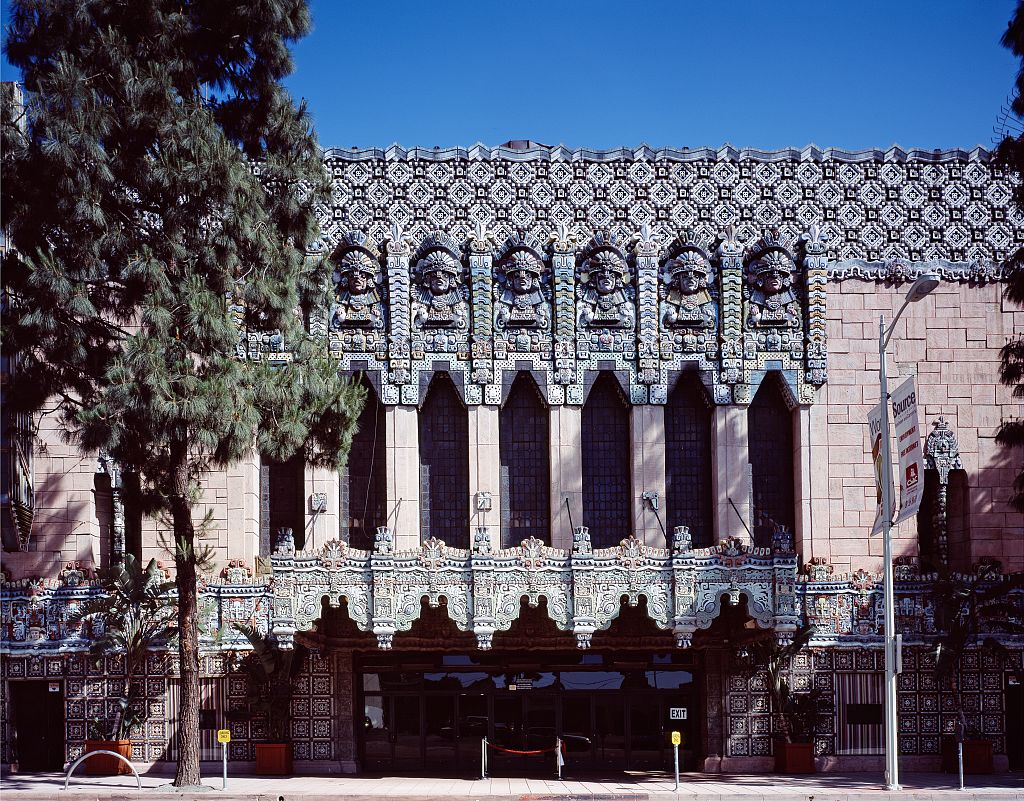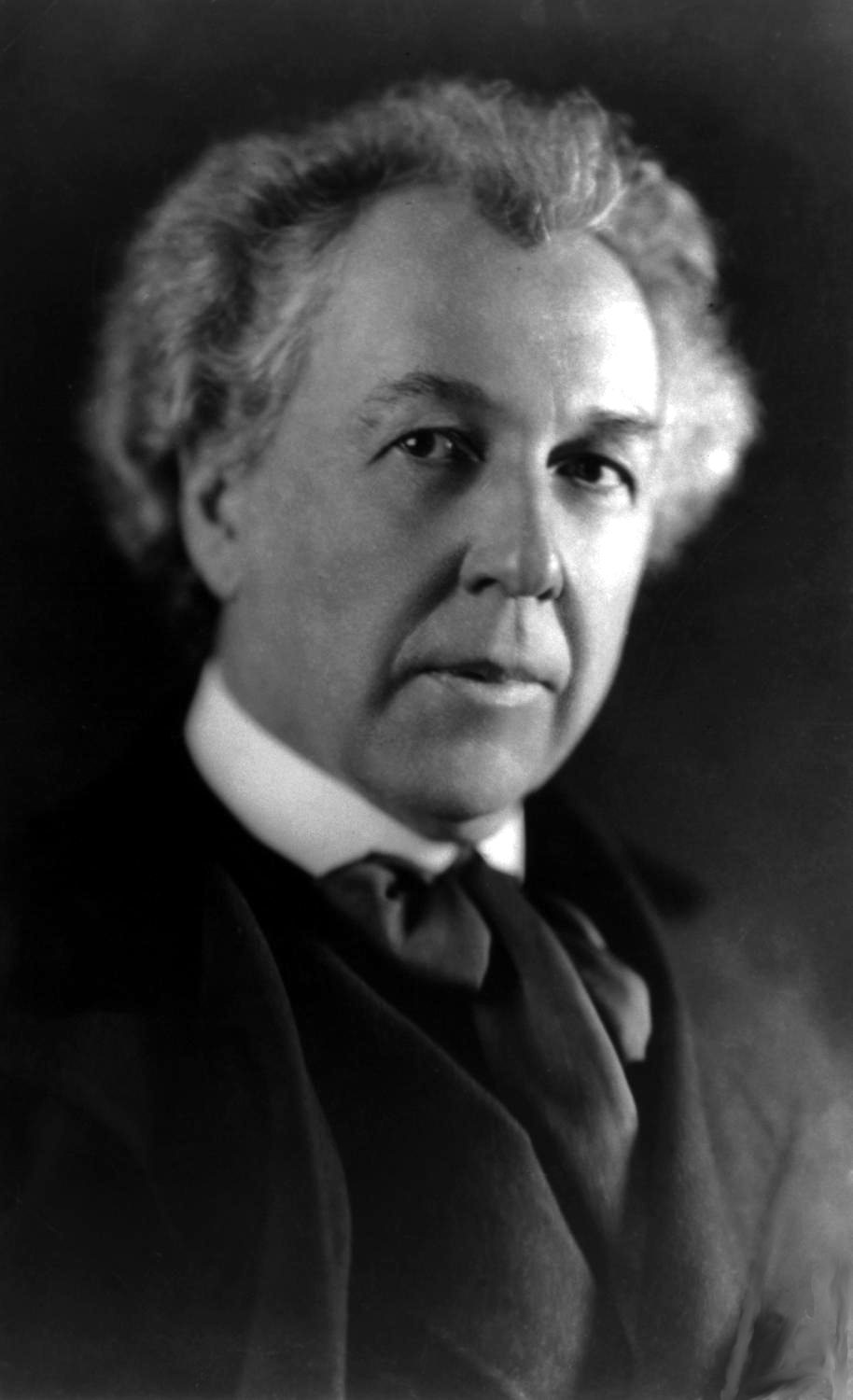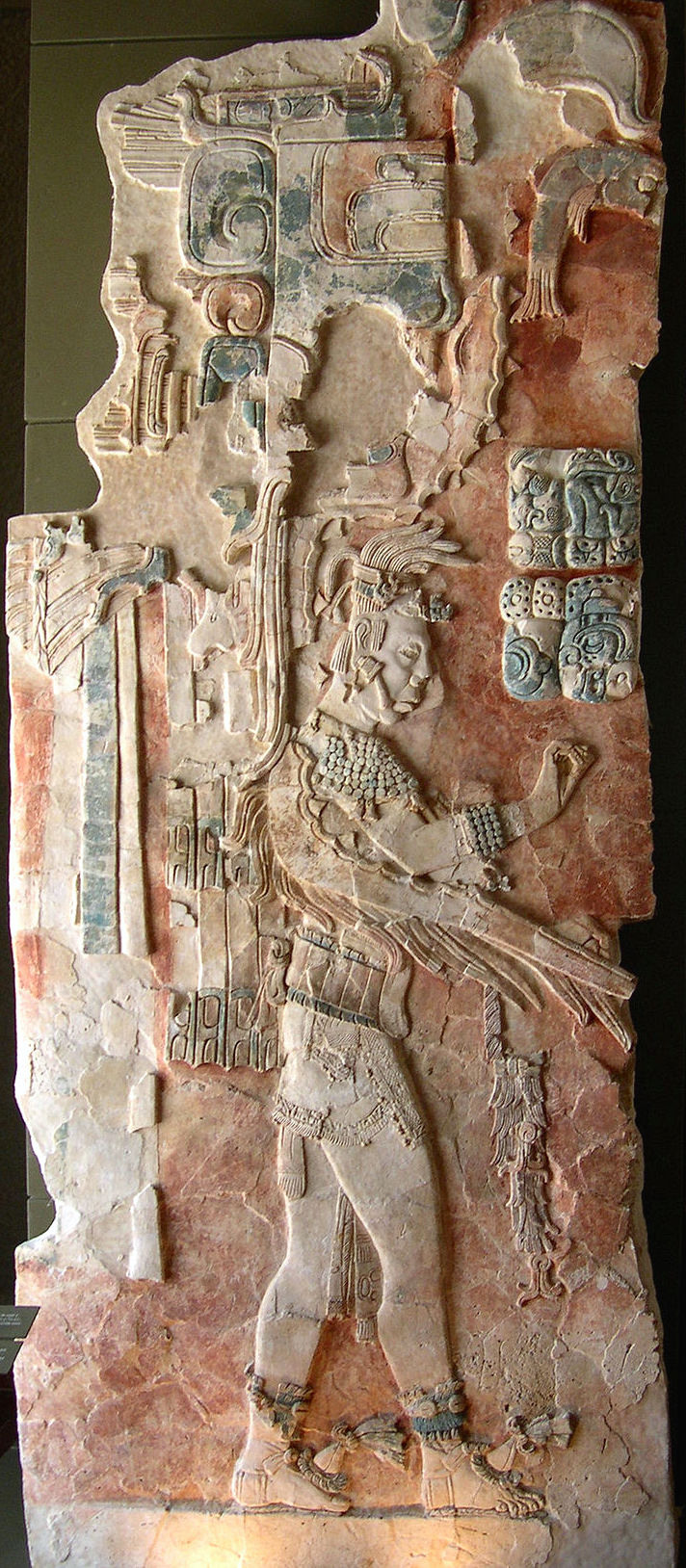|
Mayan Revival
Mayan Revival is a modern architectural style popular in the Americas during the 1920s and 1930s that drew inspiration from the architecture and iconography of pre-Columbian Mesoamerican cultures. History Origins Though the name of the style refers specifically to the Maya civilization of southern Mexico and Central America, in practice, this revivalist style frequently blends Maya architectural and artistic motifs "playful pilferings of the architectural and decorative elements" with those of other Mesoamerican cultures, particularly the Central Mexican Aztec architecture styling from the pre-contact period as exhibited by the Mexica and other Nahua groups. Although there were mutual influences between these original and otherwise distinct and richly varied pre-Columbian artistic traditions, the syncretism of these modern reproductions is often an ahistorical one. Historian Marjorie Ingle traces the history of this style to the Pan American Union Building by Paul Philip ... [...More Info...] [...Related Items...] OR: [Wikipedia] [Google] [Baidu] |
Mayan Theater Los Angeles California
Mayan most commonly refers to: * Maya peoples, various indigenous peoples of Mesoamerica and northern Central America * Maya civilization, pre-Columbian culture of Mesoamerica and northern Central America * Mayan languages, language family spoken in Mesoamerica and northern Central America * Yucatec Maya language, language spoken in the Yucatán Peninsula and northern Belize Mayan may also refer to: * Mayan, Semnan, Iran * Mayan stage, geological period that occurred during the end of the Middle Cambrian * Mayan (band), a Dutch symphonic death-metal band * Mayan (software) See also * List of Mayan languages * Maayan (other) * ''Mayan Renaissance'' * Mayan-e Olya, East Azerbaijan * Mayan-e Olya, Razavi Khorasan * Mayan-e Sofla, East Azerbaijan * Mayan-e Sofla, Razavi Khorasan * Mayan-e Vosta * Mayian Maiyan, also known as Maiyun, Haldi, or Ubtan, is the term used for the preparation ceremony one day before Punjabi wedding traditions, Punjabi weddings of India and P ... [...More Info...] [...Related Items...] OR: [Wikipedia] [Google] [Baidu] |
Maya Art
Ancient Maya art is the visual arts of the Maya civilization, an eastern and south-eastern Mesoamerican culture made up of a great number of small kingdoms in present-day Mexico, Guatemala, Belize and Honduras. Many regional artistic traditions existed side by side, usually coinciding with the changing boundaries of Maya polities. This civilization took shape in the course of the later Preclassic Period (from c. 750 BC to 100 BC), when the first cities and monumental architecture started to develop and the hieroglyphic script came into being. Its greatest artistic flowering occurred during the seven centuries of the Classic Period (c. 250 to 950 CE). Maya art forms tend to be more stiffly organized during the Early Classic (250-550 CE) and to become more expressive during the Late Classic phase (550-950 CE). In the course of history, influences of various other Mesoamerican cultures were absorbed. In the late Preclassic, the influence of the Olmec style is still discernible (as i ... [...More Info...] [...Related Items...] OR: [Wikipedia] [Google] [Baidu] |
Relief
Relief is a sculptural method in which the sculpted pieces are bonded to a solid background of the same material. The term ''relief'' is from the Latin verb ''relevo'', to raise. To create a sculpture in relief is to give the impression that the sculpted material has been raised above the background plane. When a relief is carved into a flat surface of stone (relief sculpture) or wood (relief carving), the field is actually lowered, leaving the unsculpted areas seeming higher. The approach requires a lot of chiselling away of the background, which takes a long time. On the other hand, a relief saves forming the rear of a subject, and is less fragile and more securely fixed than a sculpture in the round, especially one of a standing figure where the ankles are a potential weak point, particularly in stone. In other materials such as metal, clay, plaster stucco, ceramics or papier-mâché the form can be simply added to or raised up from the background. Monumental bronze reliefs a ... [...More Info...] [...Related Items...] OR: [Wikipedia] [Google] [Baidu] |
Textile Block House
The textile block system is a unique structural building method created by Frank Lloyd Wright in the early 1920s. While the details changed over time, the basic concept involves patterned concrete blocks reinforced by steel rods, created by pouring concrete mixture into molds, thus enabling the repetition of form. The blocks are then stacked to build walls. Wright's textile block houses are: *Ennis House *Robert and Rae Levin House (check also the other Michigan - Galesburg and Parkwin/Kalamazoo - houses at List of Frank Lloyd Wright works) *Millard House *Samuel Freeman House * Storer House (Los Angeles) *Westhope, located in Tulsa, Oklahoma Tulsa () is the second-largest city in the state of Oklahoma and 47th-most populous city in the United States. The population was 413,066 as of the 2020 census. It is the principal municipality of the Tulsa Metropolitan Area, a region with ..., Wright's only Textile Block house outside of California. References {{Frank Lloyd Wst ... [...More Info...] [...Related Items...] OR: [Wikipedia] [Google] [Baidu] |
Samuel Freeman House
The Samuel Freeman House (also known as the Samuel and Harriet Freeman House) is a Frank Lloyd Wright house in the Hollywood Hills of Los Angeles, California built in 1923. The house was listed on the National Register of Historic Places in 1971. The house has also been listed as a California Historical Landmark #1011, and as Los Angeles Historic-Cultural Monument #247 in 1981. As an example of Wright's Mayan Revival architecture, Mayan Revival or early Modernist architecture, the structure is noteworthy as one of the four textile block house, textile block houses built by Wright in the Los Angeles area, the others being Storer House (Los Angeles, California), Storer House, Ennis House, and Millard House. The construction manager on site was Wright's son, Lloyd Wright. In 1986, the Freeman House was bequeathed to the USC School of Architecture. In 2005, a stabilization project was completed using a $901,000 FEMA grant and $1.5 million in school funds. A five-year program of d ... [...More Info...] [...Related Items...] OR: [Wikipedia] [Google] [Baidu] |
Storer House (Los Angeles)
Storer House is a Frank Lloyd Wright house in the Hollywood Hills of Los Angeles built in 1923. The structure is noteworthy as one of the four Mayan Revival style textile-block houses built by Wright in the Los Angeles area from 1922 to 1924. Design of Storer House The Storer House was built in 1923 for Dr. John Storer, a homeopathic physician. Wright used the textile-block motif to "fit" the home into the hillside, trying to create the impression that the home was "a man-made extension of the landscape." However, Wright biographer Brendan Gill described the Storer House as a disappointment on this score: "In direct contradiction to everything that Wright had earlier preached about the natural, nearly invisible joining of structure and site, the Storer House, small as it is, asserts its presence with a surprising degree of arrogance—an arrogance far more obvious in the 1920s, when the hillside lacked the softening effect of foliage, than it is today." The house is dominated ... [...More Info...] [...Related Items...] OR: [Wikipedia] [Google] [Baidu] |
Millard House
Millard House, also known as La Miniatura, is a textile block house designed by Frank Lloyd Wright and built in 1923 in Pasadena, California. It was listed on the National Register of Historic Places in 1976. Wright's textile block houses The Millard House was the first of Frank Lloyd Wright's four "textile block" houses — all built in Los Angeles County in 1923 and 1924. Wright took on the Millard House following his completion of the Hollyhock House in Hollywood and the Imperial Hotel in Japan. By this time, Wright felt typecast as the Prairie house architect and sought to broaden his architectural vision. Wright turned to the concrete block as his new building material. Wright wrote in his autobiography that he chose to build with concrete blocks as they were "the cheapest (and ugliest) thing in the building world," and he wanted to see "what could be done with that gutter-rat." The textile-block houses were named for their richly textured brocade-like concrete walls. ... [...More Info...] [...Related Items...] OR: [Wikipedia] [Google] [Baidu] |
Ennis House
The Ennis House is a residential dwelling in the Los Feliz neighborhood of Los Angeles, California, United States, south of Griffith Park. The home was designed by Frank Lloyd Wright for Charles and Mabel Ennis in 1923 and was built in 1924. Following '' La Miniatura'' in Pasadena, and the Storer and Freeman Houses in the Hollywood Hills of Los Angeles, the structure is the fourth and largest of Wright's textile block designs, constructed primarily of interlocking pre-cast concrete blocks, in the northern Los Angeles area. The design is based on ancient Maya temples, and along with other buildings by Frank Lloyd Wright, such as the A. D. German Warehouse in Wisconsin and Aline Barnsdall Hollyhock House in Hollywood, the Ennis House is sometimes referred to as an example of the Mayan Revival architecture. Its prominent detail is the relief ornamentation on its 27,000 perforated and patterned decomposed granite blocks,James McClain (October 16, 2019)Frank Lloyd Wright’s Ennis ... [...More Info...] [...Related Items...] OR: [Wikipedia] [Google] [Baidu] |
Mesoamerican Pyramid
Mesoamerican pyramids form a prominent part of ancient Mesoamerican architecture. Although similar in some ways to Egyptian pyramids, these New World structures have flat tops (many with temples on the top) and stairs ascending their faces. The largest pyramid in the world by volume is the Great Pyramid of Cholula, in the east-central Mexican state of Puebla. The builders of certain classic Mesoamerican pyramids have decorated them copiously with stories about the Hero Twins, the feathered serpent Quetzalcoatl, Mesoamerican creation myths, ritualistic sacrifice, etc. written in the form of hieroglyphs on the rises of the steps of the pyramids, on the walls, and on the sculptures contained within. Aztec pyramids The Aztecs dominated central Mexico in the 14th, 15th and 16th centuries. Their capital was Tenochtitlan on the shore of Lake Texcoco – the site of modern-day Mexico City. They were related to the preceding cultures in the basin of Mexico such as the culture of Teot ... [...More Info...] [...Related Items...] OR: [Wikipedia] [Google] [Baidu] |
Tokyo
Tokyo (; ja, 東京, , ), officially the Tokyo Metropolis ( ja, 東京都, label=none, ), is the capital and largest city of Japan. Formerly known as Edo, its metropolitan area () is the most populous in the world, with an estimated 37.468 million residents ; the city proper has a population of 13.99 million people. Located at the head of Tokyo Bay, the prefecture forms part of the Kantō region on the central coast of Honshu, Japan's largest island. Tokyo serves as Japan's economic center and is the seat of both the Japanese government and the Emperor of Japan. Originally a fishing village named Edo, the city became politically prominent in 1603, when it became the seat of the Tokugawa shogunate. By the mid-18th century, Edo was one of the most populous cities in the world with a population of over one million people. Following the Meiji Restoration of 1868, the imperial capital in Kyoto was moved to Edo, which was renamed "Tokyo" (). Tokyo was devastate ... [...More Info...] [...Related Items...] OR: [Wikipedia] [Google] [Baidu] |
Imperial Hotel, Tokyo
The is a hotel in Uchisaiwaicho, Chiyoda ward, Tokyo. It was created in the late 1880s at the request of the Japanese aristocracy to cater to the increasing number of Western visitors to Japan. The hotel site is located just south of the Imperial Palace grounds, next to the previous location of the Palace moat. The modern hotel overlooks the Palace, the Western-style Hibiya Park, and the Yurakucho and Ginza neighborhoods. Three main buildings have stood on the hotel site, each of which embodied the finest Western design of its era. Including annexes, there have been at least 10 structures that have been part of the Imperial Hotel, including two designed by Frank Lloyd Wright: *The original Imperial Hotel, designed by Yuzuru Watanabe (1890–1922) *Hotel Metropole in Tsukiji, purchased as an annex (1906–1910) *First Imperial Hotel annex (1906–1919) *A temporary annex, designed by Wright when the original hotel annex burnt (1920–1923) *New Imperial Hotel main building, ... [...More Info...] [...Related Items...] OR: [Wikipedia] [Google] [Baidu] |
Palenque
Palenque (; Yucatec Maya language, Yucatec Maya: ), also anciently known in the Itza Language as Lakamhaʼ ("Big Water or Big Waters"), was a Maya city City-state, state in southern Mexico that perished in the 8th century. The Palenque ruins date from ca. 226 BC to ca. 799 AD. After its decline, it was overgrown by the Selva Lacandona, jungle of cedar, mahogany, and sapodilla trees, but has since been excavated and restored. It is located near the Usumacinta River in the Mexican state of Chiapas, about 130 km (81 mi) south of Ciudad del Carmen, above sea level. It averages a humid 26°C (79°F) with roughly of rain a year. Palenque is a medium-sized site, smaller than Tikal, Chichen Itza, or Copán, but it contains some of the finest architecture, sculpture, roof comb and bas-relief carvings that the Maya civilization, Mayas produced. Much of the history of Palenque has been reconstructed from reading the hieroglyphic inscriptions on the many monuments; historians now have a l ... [...More Info...] [...Related Items...] OR: [Wikipedia] [Google] [Baidu] |



_(28134002710).jpg)

.jpg)


